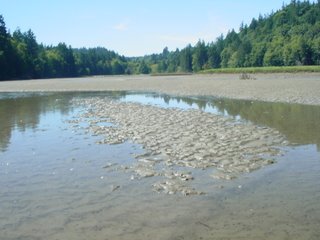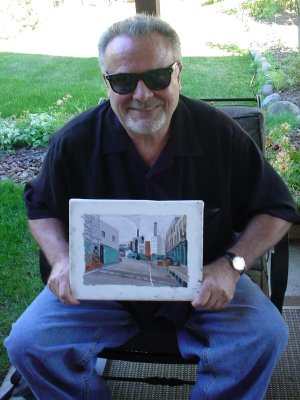 We packed a few things and headed out to Seabeck for a day of canoeing on Sunday. The weather was great, and the paddle started out with still water - perfect paddling conditions. Since we had Daisy along, the challenge was to have a short drive, and then find a location that was interesting to a ten year old child.
We packed a few things and headed out to Seabeck for a day of canoeing on Sunday. The weather was great, and the paddle started out with still water - perfect paddling conditions. Since we had Daisy along, the challenge was to have a short drive, and then find a location that was interesting to a ten year old child.  The beaches along Seabeck are oyster beaches, with clams in the sand, thousands of mussel shells, and plenty of detritus along the beach. I loved the exquisite colors in this mussel shell.
The beaches along Seabeck are oyster beaches, with clams in the sand, thousands of mussel shells, and plenty of detritus along the beach. I loved the exquisite colors in this mussel shell. The skeleton of this crab had interesting muted colors. We noticed red rock crab scuttling the intertidal area to forage for food. Purple shore crabs, porcelain crabs and hairy cancer crabs frequently hide under the rocks along the shoreline. When I showed this skeleton to Daisy, she would not go near it. She has gone on over 50 canoe paddles with us over the past 4 years, and has yet to touch seaweed! (She says it looks slimy.)
The skeleton of this crab had interesting muted colors. We noticed red rock crab scuttling the intertidal area to forage for food. Purple shore crabs, porcelain crabs and hairy cancer crabs frequently hide under the rocks along the shoreline. When I showed this skeleton to Daisy, she would not go near it. She has gone on over 50 canoe paddles with us over the past 4 years, and has yet to touch seaweed! (She says it looks slimy.) We canoed down to Ricketts Beach, where there is a boathouse and community center (private) . The boats lined up along the shoreline were nested in the grass, and looked like they were not in use this season.
We canoed down to Ricketts Beach, where there is a boathouse and community center (private) . The boats lined up along the shoreline were nested in the grass, and looked like they were not in use this season. As we glided along, I pointed out schools of tiny salmon, swirling in the water under the canoe. They would dart away as we approached.
 There were also starfish, some, like these red ones were exposed in shallow tide pools as the tide receeded. The colors are varied; reds, oranges, and blue-greens. These little critters are very tough-skinned, and cannot be pried off the rocks. Sometimes, we see varieties with as many as 18 legs.
There were also starfish, some, like these red ones were exposed in shallow tide pools as the tide receeded. The colors are varied; reds, oranges, and blue-greens. These little critters are very tough-skinned, and cannot be pried off the rocks. Sometimes, we see varieties with as many as 18 legs.  We skimmed along into a shallow inlet, where a family was picnicing. They, too had a canoe, and were drifting with the current and exploring the rock and mud bottom where northern clingfish, penpoint gunnels, high cockscomb, and sculpins scurry into to the mud.
We skimmed along into a shallow inlet, where a family was picnicing. They, too had a canoe, and were drifting with the current and exploring the rock and mud bottom where northern clingfish, penpoint gunnels, high cockscomb, and sculpins scurry into to the mud.  The muddy tide-flats required pole-pushing much like one does with a raft. Daisy pushed in the middle, and George and I pushed from both ends. We went as far as we could, before getting stuck.
The muddy tide-flats required pole-pushing much like one does with a raft. Daisy pushed in the middle, and George and I pushed from both ends. We went as far as we could, before getting stuck.  This old fishing boat, the Orca, had seen better days. The waves had completely broken it, and the innards were rusted and full of cobwebs. Nobody except me seemed interested in exploring this old boat.
This old fishing boat, the Orca, had seen better days. The waves had completely broken it, and the innards were rusted and full of cobwebs. Nobody except me seemed interested in exploring this old boat.So Daisy and George sat in the sun while I checked out the innards. I would have loved to fish from this old boat.
The tide was starting to change, with swells coming in, and George motioned me back to the canoe. We had some hard paddling, with a head wind, for the hour paddle back. People were out enjoying the water, and we enjoyed greeting families swimming and boating in the water. The temperature changed suddenly from warm and sunny to a brisk breeze. I put on my sweatshirt to keep warm.

When Daisy got hungry, George teased her by saying, "Oh, just wait. There's a catered lunch just around the bend!" Not falling for that line, I asked to stop at this little espresso place in Seabeck for coffee and chocolate chip cookies once we'd loaded up the canoe. Daisy had a Kiddie Grande, chocolate milk and I enjoyed my usual, an espresso with hot milk and sugar.
Rick, from Silverdale, comes here on weekends to play his guitar. He says he's lived in the area all his life. He loves to visit with the tourists and play his music.

He said that every year state and tribal shellfish biologists perform clam and oyster surveys on the beaches. They record data about water temperatures, food availability, harvest, disease, flooding and other environmental disturbances wich then determines the annual clam and oyster quotas. Half of the quota on every public beach is available to sport harvesters (the state share) and the other half goes to treaty tribes (the tribal share).
 We saw this little miniature submarine on a hill along the highway. It has been festooned with Christmas lights.
We saw this little miniature submarine on a hill along the highway. It has been festooned with Christmas lights. The Big Beef Creek Field Station near Seabeck is part of the field studies of oceans and fisheries. It conducts studies on oysters, clams, and mussels to providing information and assistance to the shellfish industry.
 I walked along a field at the research station, where old farm machinery was displayed. I like the old colors and the com- plexity. It's all a mystery to me, what everything does, what it is for.
I walked along a field at the research station, where old farm machinery was displayed. I like the old colors and the com- plexity. It's all a mystery to me, what everything does, what it is for. These were wheels to an old tiller. I like the grass poking through the spokes.
These were wheels to an old tiller. I like the grass poking through the spokes.And, wouldn't you know it, for all our vigorous paddling to get back to our 'put-in place', we still got stuck in traffic near the Narrows Bridge. It came to a slow crawl, and we were stranded for awhile. George started tapping his fingers, worried, because our Ruhi Class starts at 4:30.
 I told him that if we are late, people will go to the patio out back and start the class without us. Fortu- nately, Kay was there, brushing up on details. She is the fascilitator. And, Barry dropped by for the Ruhi Class, eager to show us his new oil painting.
I told him that if we are late, people will go to the patio out back and start the class without us. Fortu- nately, Kay was there, brushing up on details. She is the fascilitator. And, Barry dropped by for the Ruhi Class, eager to show us his new oil painting.  It is an image of the pulp mill where one of his friends works. We gingerly passed it around as the paint was still slightly wet. I put it on top of the washing machine during our class, where the cats were not likely to step on it.
It is an image of the pulp mill where one of his friends works. We gingerly passed it around as the paint was still slightly wet. I put it on top of the washing machine during our class, where the cats were not likely to step on it.